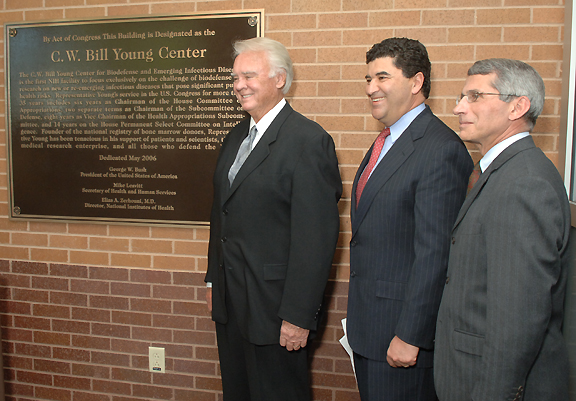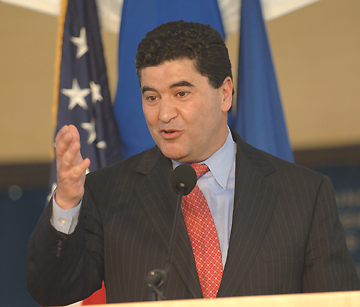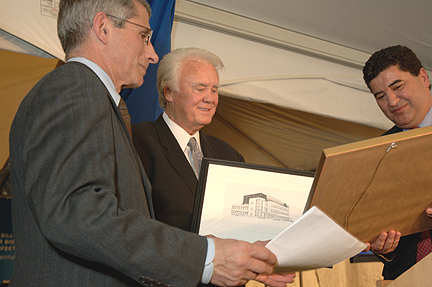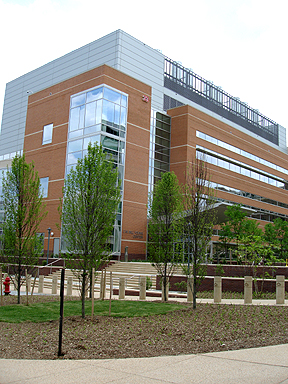| T
H E N I H C A T A L Y
S T |
M
A Y – J U
N E 2006 |
|
Building
33 Dedicated May 2
BIODEFENSE
AND EMERGING
INFECTIOUS DISEASES
RESEARCH
BUILDING
READIED FOR PRIME
TIME
|
|
 |
On
Deck: (left to right) Rep.
C.W. Bill Young (R.-Fla.), for whom the new building is named, is joined
by NIH Director Elias Zerhouni and NIAID Director Anthony Fauci alongside
the Building 33 commemorative plaque, which reads:
"By Act of Congress
This Building is Dedicated as the
C.W. Bill Young Center
The C.W. Bill Young
Center for Biodefense and Emerging Infectious Diseases is the first
NIH facility to focus exclusively on the challenge of biodefense and
research on new or re-emerging infectious diseases that pose significant
public health risks. Representative Young's service in the U.S. Congress
for more than 35 years includes six years as Chairman of the House Committee
on Appropriations, two separate terms as chairman of the Subcommittee
on Defense, eight years as Chairman of the Health Appropriations Subcommittee,
and 14 years on the House Permanent Select Committee on Intelligence.
Founder of the national registry of bone marrow donors, Representative
Young has been tenacious in his support of patients and scientists,
the biomedical research enterprise, and all those who defend the Nation.
Dedicated May 2006"�
|
The
vision of the building dedicated on the NIH campus in May 2006
started taking shape in the fall of 2001—it rose from incinerated buildings
and powdery envelopes in the New York and Washington, D.C., areas.
Accelerating
research to defend against bioterrorism was a driving force behind the concept
of Building 33.
But
its development—like that of the NIAID biodefense research agenda and strategic
plan, issued in early 2002—was firmly grounded in the context of emerging
and re-emerging infectious diseases.
The
science does not turn on whether the involved pathogens "are naturally
occurring or deliberately perpetrated,"NIAID Director Anthony
Fauci observed in a speech during the ceremony to dedicate the brick, glass,
and steel structure where that
research will now be concentrated.
The
new facility, Fauci noted, will enable the "gathering under one roof of
a critical mass of researchers currently scattered in many buildings around
this campus," whose work with a variety of respiratory viruses and bacteria
will benefit from the "creative synergies" fostered by the new infrastructure.
The
building houses animal care-areas, conference rooms, offices, and biosafety
level 2 and 3 laboratories—adding another 14,300 square foot of BSL-3 lab
space to NIAID's current 4,700 square feet. Researchers working in the BSL-3
labs will wear special protective equipment and receive specialized training
in state-of-the-art techniques for handling BSL-3 pathogens.
The
new center will consolidate and expand NIAID's existing research programs on
 Respiratory
viruses (such as influenza and avian flu)
Respiratory
viruses (such as influenza and avian flu)
 Respiratory
bacteria, such as multidrug-resistant TB and anthrax)
Respiratory
bacteria, such as multidrug-resistant TB and anthrax)
 Insect-borne
viruses (such as West Nile and dengue)
Insect-borne
viruses (such as West Nile and dengue)
 Immunology
of infectious diseases
Immunology
of infectious diseases
 Development
of vaccines for infectious diseases
Development
of vaccines for infectious diseases
A
new program focusing on innate immunity will also be established in Building
33. Fauci noted that pathogens requiring BSL-4 facilities will not be studied
in the new center.
—Fran
Pollner
 |
 |
 |
Building
33, NIH Director Elias
Zerhouni noted with pride, emerged "on time, on budget,"�
but had obstacles to overcome, not the least of which was the concern
of the surrounding Bethesda community about potential environmental risks.
Detailed explanations of the building's design, security, and safeguards
were not quite convincing enough, Zerhouni recalled."But then I told
them that I guarantee that Tony Fauci will have his office right in the
middle of that building—and that won the day!"�
|
Flanked
by NIAID Director Anthony Fauci and NIH Director Elias Zerhouni, Rep.
C.W. Bill Young receives gifts of gratitude for his "unwavering support
for biomedical research"—an artist's rendering of Building 33
and a certificate commemorating the day's event
|
The
latest addition to the NIH research complex, Building 33 will house about
250 laboratory, administrative, and support staff within its four stories
and 12 intramural research laboratories. Construction was begun in November
2003 and completed in December 2005; move-in is anticipated throughout
the summer of 2006.
|
Return
to Table of Contents



